Theodore Roosevelt, Jr.
| Brigadier General Theodore Roosevelt, Jr. |
|
 |
|
|
Governor General of the Philippines
|
|
| In office February 29, 1932 – July 15, 1933 |
|
| President | Herbert Hoover Franklin D. Roosevelt |
|---|---|
| Preceded by | Dwight F. Davis |
| Succeeded by | Frank Murphy |
|
Governor of Puerto Rico
|
|
| In office 1929–1932 |
|
| President | Herbert Hoover |
| Preceded by | James R. Beverley |
| Succeeded by | James R. Beverley |
|
Assistant Secretary of the Navy
|
|
| In office March 10, 1921 – September 30, 1924 |
|
| President | Warren Harding Calvin Coolidge |
| Preceded by | Theodore Douglas Robinson |
| Succeeded by | Ernest L. Jahncke |
|
Member of the
New York State Assembly for the 2nd District |
|
| In office 1920–1921 |
|
| Preceded by | Franklin Coles |
| Succeeded by | Frederick Trubee Davison |
|
|
|
| Born | September 13, 1887 Cove Neck, New York |
| Died | July 12, 1944 (aged 56) Near Normandy, France |
| Political party | Republican |
| Military service | |
| Allegiance | United States of America |
| Years of service | 1917–1919 1940–1944 |
| Rank | |
| Commands | 26th Infantry Regiment (United States) |
| Battles/wars | World War I World War II *Operation Torch *Operation Husky *Battle of Normandy |
| Awards | |
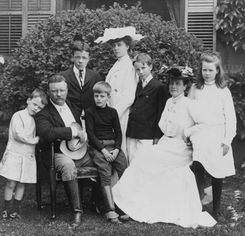
Theodore D. Roosevelt, Jr.[1] (September 13, 1887 – July 12, 1944), or Theodore D. Roosevelt II, was an American political and business leader, a Medal of Honor recipient who fought in both of the 20th century's world wars. He was the eldest son of President Theodore Roosevelt and his second wife Edith. Roosevelt served as Assistant Secretary of the Navy, Governor of Puerto Rico (1929–32), Governor-General of the Philippines (1932–33), Chairman of the Board of American Express Company, and Vice-President at Doubleday Books, and as a Brigadier General in the United States Army.
Contents |
Childhood
"Teddy," as he was, in childhood, universally known, was the son of President Theodore Roosevelt. He was born at the family estate in Oyster Bay Cove, New York, when his father was just starting his political career. His siblings were brothers Archibald (nicknamed "Archie"), Quentin, and Kermit; sister Ethel; and half-sister Alice.
Like all the Roosevelt children, Ted was tremendously influenced by his father. In later life, Ted would record some of these childhood recollections in a series of newspaper articles written around the time of World War I. One day when he was about nine, TR gave young Ted a rifle. Ted was so excited and wanted to see if it worked, so after promising not to tell mother, he fired a small shot into the roof. They never got caught for that.
When Ted was a child, his father initially expected more of him than of his siblings – an added burden that almost caused him to suffer a nervous breakdown.[2]
In one article, Ted recalled his first time in Washington when the elder Theodore was Civil Service Commissioner, "... when father was civil service commissioner I often walked to the office with him. On the way down he would talk history to me—not the dry history of dates and charters, but the history where you yourself in your imagination could assume the role of the principal actors, as every well-constructed boy wishes to do when interested. During every battle we would stop and father would draw out the full plan in the dust in the gutter with the tip of his umbrella. Long before the European war had broken over the world father would discuss with us military training and the necessity for every man being able to take his part."[3]

Education

Unlike his little brother Quentin, who, like his father, was naturally gifted intellectually and sailed through Harvard, studies did not come easy for Ted. He persisted however and graduated from Harvard University in 1908 after attending Groton School where he became, like his father, a member of the Porcellian Club. After graduating from college, he entered the business world. He took positions in the steel business and carpet business before becoming the branch manager of an investment bank. He had a flair for business and amassed a considerable fortune in the years leading up to World War I and on into the 1920s. The income from his investments stood him in good stead to become involved in politics after the War. Before he went to college, he thought about going to military school.
Political career
After service in World War I (see below), Roosevelt began his political career. In 1919 he was elected to the New York State Assembly.[4] Grinning like his father, waving a crumpled hat, and like his father, shouting "bully," Ted participated in every national campaign that he could except when he was Governor-General of the Philippines.
In 1921, when Warren G. Harding was elected president, Roosevelt was appointed Assistant Secretary of the Navy. Here he oversaw the transferring of oil leases from the Navy to private corporations. The Navy's petroleum reserves consisted of three fields (which had been established by President Taft); Naval Petroleum Reserve No. 3, Teapot Dome Field, Natrona County, Wyoming; and Naval Petroleum Reserve No. 1 at Elk Hills Oil Field and Naval Petroleum Reserve No. 2 Buena Vista Oil Field both in Kern County, California. In 1922, Albert B. Fall, U.S. Secretary of the Interior, leased, without competitive bidding, the Teapot Dome Field to Harry F. Sinclair of Sinclair Consolidated Oil Company, and the field at Elk Hills, California, to Edward L. Doheny of Pan American Petroleum & Transport Company. During the transfers, while he was Assistant Secretary of the Navy, his brother Archibald B. Roosevelt, Sr., was vice president of the Union Petroleum Company, the export auxiliary subsidiary of the Sinclair Consolidated Oil. All of this came to be known as the Teapot Dome scandal. The connection between the Roosevelt brothers could not be ignored. After Sinclair sailed for Europe to avoid testifying, G. D. Wahlberg, Sinclair's private secretary, advised Archibald Roosevelt to resign to save his reputation.[5] Although both Archibald and Ted Roosevelt were cleared of all charges, their images were tarnished.
In 1924, he was the Republican nominee for Governor of New York. His cousin Franklin D. Roosevelt (FDR) spoke out on Ted's "wretched record" as Assistant Secretary of the Navy during the oil scandals. Eleanor Roosevelt played her part as well in ending Ted's political future. She campaigned vigorously to link Ted to the recent Teapot Dome Scandal, going so far as to follow him around in a car around New York State with a steaming teapot on its roof.[6] Eleanor used that campaign tactic after Ted commented of FDR, comparing him to Ted's father, TR, "He's a maverick! He does not wear the brand of our family." Eleanor had been infuriated by these remarks. She would later decry these methods, admitting that they were below her dignity but saying that they had been contrived by Democratic Party dirty tricksters. Ted never forgave Eleanor for her stunt, though his half-sister, Alice Longworth, later forgave Eleanor and resumed their formerly close friendship. These conflicts served to widen the split between the Oyster Bay TR and Hyde Park FDR wings of the Roosevelt family. Because of Eleanor's efforts Ted lost the support of many of his would-be voters. His opponent, incumbent governor Alfred E. Smith, defeated him by 105,000 votes. But in the simultaneous race for President, the Republican Calvin Coolidge won New York by over 850,000 votes. If Ted Roosevelt had won the governorship of New York in 1924, FDR's chances for the 1928 New York governorship and the 1932 presidency would have been less favorable.

Colonial Governor
In September 1929, President Herbert Hoover appointed Ted Governor of Puerto Rico. As governor, he did his best to ease the island's poverty. He was fond of local Puerto Rican culture and assumed many of the island's traditions. He became known as the "Jibarito de La Fortaleza" by locals.
Hoover was impressed with his work in Puerto Rico and appointed him Governor-General of the Philippines in 1932. While Governor-General of the Philippines, Roosevelt acquired the nickname "One Shot Teddy" among the Filipino population, in reference to his marksmanship during a hunt for tamaraw (wild pygmy water buffalo). There may have been some sarcasm behind the nickname, although this is not supported by his other known feats of marksmanship in hunting and in combat.
In 1932, when FDR challenged Hoover for the presidency, Ted's half-sister, Alice Roosevelt Longworth (whose dislike for her Democratic cousin FDR was "intensely real," as Time magazine at that time described it), begged Ted to return from the Philippines to take to the stump. Ted announced to the press on August 22, 1932, that "Circumstances have made it necessary for me to return for a brief period to the United States.... I shall start for the Philippines again the first week in November.... While there I hope I can accomplish something." The reaction of many in the US press was so negative that within a few weeks, it was suddenly arranged for Governor-General Roosevelt to remain at Manila throughout the campaign. Secretary of War Hurley cabled Ted, "The President has reached the conclusion that you should not leave your duties for the purpose of participating in the campaign.... He believes it to be your duty to remain at your post."[7] Ted's resignation as Governor-General of the Philippines after the election of FDR effectively ended his political career. But he saw the war clouds gathering in Europe as a way to capture what he and his father had found on the battlefield: glory and political opportunity. All he would have to do was physically survive the next conflict. He would write his wife as he sailed for North Africa, using his father's language, that he had done his best and his fate was now "at the knees of the gods."
Return to the United States
While Governor General of the Philippines, Ted Jr., who continued to have political aspirations to follow in his father's Presidential footsteps, complained during the 1932 presidential campaign of his cousin FDR, "Franklin is such poor stuff it seems improbable that he should be elected President." When Franklin won the election and Ted was asked just how he was related to FDR, he humorously described himself as "fifth cousin about to be removed." He shortly thereafter resigned his office. In 1935, he returned to the United States and first became a vice president of the publishing house Doubleday, Doran & Company, then an executive with American Express. He also served on the boards of numerous not-for-profit organizations, and was asked by Irving Berlin to help oversee the disbursement of royalties for Berlin's "God Bless America" to charity. Living again in New York, the Roosevelts also renewed old friendships with such luminaries as Alexander Woolcott and Harpo Marx.
Military service
World War I service
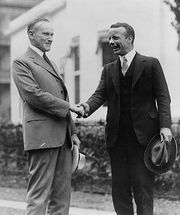
All the Roosevelt sons except Kermit had had some military training prior to World War I. With the outbreak of war in Europe in August 1914, there had been a heightened concern about the nation's readiness for military engagement. Only the month before, Congress had belatedly recognized the significance of military aviation by authorizing the creation of an Aviation Section in the Signal Corps. In 1915, Major General Leonard Wood, President Roosevelt's former commanding officer during the Spanish-American War, organized a summer camp at Plattsburgh, New York, to provide military training for business and professional men at their own expense. It would be this summer training program that would provide the basis of a greatly expanded junior officers' corps when the country entered World War I. During that fateful summer of 1915, many well-heeled young men from some of the finest East Coast schools, including all three Roosevelt sons, would attend the camp. When the United States entered the war, commissions were offered to the graduates of these schools based on their performance. The National Defense Act of 1916 continued the student military training and the businessmen's summer camps and placed them on a firmer legal basis by authorizing an Officers' Reserve Corps and a Reserve Officers' Training Corps (ROTC).
After the declaration of war, when the American Expeditionary Force (AEF) was organizing, the Roosevelt boys' father, Theodore, wired Major General "Black Jack" Pershing asking if his sons could accompany him to Europe as privates. Pershing accepted, but, based on their training at Plattsburgh, Archie was offered a commission with rank of second lieutenant, while Ted, Jr., was offered a commission and the rank of major. Quentin had already been accepted into the fledgling Army Air Service. Kermit would volunteer with the British in the area that would eventually become modern-day Iraq.
Ted, having a reserve commission in the Army (as did two of his brothers, Quentin and Archibald) was called up shortly after World War I broke out. When the United States declared war on Germany, Ted volunteered to be one of the first soldiers to go to France. There, Ted distinguished himself as the best battalion commander in his division, according to the division commander himself. He braved hostile fire and gas and led his battalion in combat. So concerned was he for his men's welfare that he even purchased combat boots for the entire battalion with his own money. He eventually commanded the US Army's 26th Regiment in the First Division as lieutenant colonel. He fought in several major battles. He was gassed and wounded at Soissons during the summer of 1918. In July of that year his brother Quentin was killed in combat. Teddy received the Distinguished Service Cross for his action during the war. Before the troops even came home from France, Ted was one of the originators and founders of the soldiers' organization that would become the American Legion. The American Legion's Post Officers Guide recounts Ted's part in the organization's founding:
A group of twenty officers who served in the American Expeditionary Forces (A.E.F.) in France in World War I is credited with planning the Legion. A.E.F. Headquarters asked these officers to suggest ideas on how to improve troop morale. One officer, Lieutenant Colonel Theodore Roosevelt, Jr., proposed an organization of veterans. In February 1919, this group formed a temporary committee and selected several hundred officers who had the confidence and respect of the whole army. When the first organization meeting took place in Paris in March 1919, about 1,000 officers and enlisted men attended. The meeting, known as the Paris Caucus, adopted a temporary constitution and the name The American Legion. It also elected an executive committee to complete the organization’s work. It considered each soldier of the A.E.F. a member of the Legion. The executive committee named a subcommittee to organize veterans at home in the U.S. The Legion held a second organizing caucus in St. Louis, Missouri, in May 1919. It completed the constitution and made plans for a permanent organization. It set up temporary headquarters in New York City, and began its relief, employment, and Americanism programs. Congress granted the Legion a national charter in September 1919.[8]
When the American Legion met in New York City and Ted was nominated to become the Legion's first national commander, he refused because he did not want his acceptance to be seen as nothing more than a political move on his part. Acceptance under such circumstances could have discredited the nascent organization and harmed Ted's own chances for a future in politics.
Ted resumed his reserve service between the wars. He attended the annual summer camps at Pine Camp and completed both the Infantry Officer's Basic and Advanced Courses and the Command and General Staff College, and so was eligible for senior commissioned service in World War II.
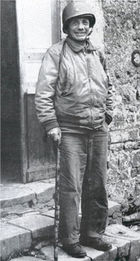
World War II service and death

In 1940, he attended a military refresher course offered to many businessmen as an advanced student, and was promoted to colonel in the Army of the United States. He returned to active duty in April 1941 and was given command of the 26th Infantry Regiment, 1st Infantry Division, the same group he fought with in World War I. Late in 1941, he was promoted to brigadier general.
North Africa Campaign
Upon his arrival in North Africa, he was soon known as a general who often visited the front lines. He had always preferred the heat of the battle to the comfort of the command post, and this attitude would culminate in his actions in France on D-Day.
Roosevelt led his regiment in an attack on Oran, Africa, on November 8, 1942. During 1943, he was the second-in-command of the U.S. 1st Infantry Division that fought in the North African Campaign under Major General Terry Allen. He was cited for the Croix de Guerre by the military commander of French Africa, General Alphonse Juin:
- "As commander of a Franco-American detachment on the Ousseltia plain in the region of Pichon, in the face of a very aggressive enemy, he showed the finest qualities of decision and determination in the defense of his sector.
- "Showing complete contempt for personal danger, he never ceased during the period of Jan 28 – Feb 21, visiting troops in the front lines, making vital decisions on the spot, winning the esteem and admiration of the units under his command and developing throughout his detachment the finest fraternity of arms."
Clashes with Patton
Roosevelt's collaboration and friendship with his commander, the hard-fighting, hard-drinking Allen, and their unorthodox approach to warfare, did not escape the attention of General George S. Patton. Patton disapproved of officers like Roosevelt and Allen, who "dressed down" and were seldom seen in regulation field uniforms, and who placed little value in Patton's spit-shined ways in the field. Patton thought them both un-soldierly for it and wasted no opportunity to send derogatory reports on Allen to the Supreme Allied Commander. Roosevelt was also treated by Patton as "guilty by association" for his friendship and collaboration with the highly unorthodox Allen. When Allen was relieved of command of the First Division and re-assigned, so was Roosevelt. After criticizing Terry Allen in his diary on July 31, 1943, Patton recorded that he was going to relieve both Allen and Roosevelt, noting that he had asked permission of Eisenhower "to relieve both Allen and Roosevelt on the same terms, on the theory of rotation of command," and adding, concerning Roosevelt, "there will be a kick over Teddy, but he has to go, brave but otherwise, no soldier." Roosevelt was also criticized by General Omar Bradley, who ultimately relieved both Allen and Roosevelt of their commands after he assumed command of the 7th Army.[9] According to Bradley, in both of his autobiographies "A Soldier's Story (1951)" and "A General's Life", he claimed that relieving both Allen and Roosevelt, was one of his most unpleasant duties of the war.[10]
Roosevelt saw action in Sicily, commanded Allied Forces in Sardinia, and fought on the Italian mainland. He was the chief liaison officer to the French Army in Italy for General Dwight D. Eisenhower, and repeatedly made requests of Eisenhower for combat command.
D-Day
In February 1944, Roosevelt was assigned to England to help lead the Normandy invasion. He was assigned to the staff of the U.S. 4th Infantry Division. After several verbal requests to the division's commanding officer, Maj. General "Tubby" Barton, were denied, Roosevelt sent a written petition:
The force and skill with which the first elements hit the beach and proceed may determine the ultimate success of the operation.... With troops engaged for the first time, the behavior pattern of all is apt to be set by those first engagements. [It is] considered that accurate information of the existing situation should be available for each succeeding element as it lands. You should have when you get to shore an overall picture in which you can place confidence. I believe I can contribute materially on all of the above by going in with the assault companies. Furthermore I personally know both officers and men of these advance units and believe that it will steady them to know that I am with them.[11]
Barton approved this letter with much misgiving, stating that he did not expect Roosevelt to return alive.
Roosevelt would be the only general on D-Day to land by sea with the first wave of troops. He was one of the first soldiers, along with Capt. Leonard T. Schroeder Jr., off his landing craft as he led the U.S. 4th Infantry Division's 8th Infantry Regiment and 70th Tank Battalion landing at Utah Beach. Roosevelt was soon informed that the landing craft had drifted more than a mile south of their objective, and the first wave was a mile off course. Walking with the aid of a cane and carrying a pistol, he personally made a reconnaissance of the area immediately to the rear of the beach to locate the causeways that were to be used for the advance inland. He then returned to the point of landing and contacted the commanders of the two battalions, Lt. Cols. Conrad C. Simmons and Carlton O. MacNeely, and coordinated the attack on the enemy positions confronting them. Roosevelt's famous words in these circumstances were, "We’ll start the war from right here!" These impromptu plans worked with complete success and little confusion. With artillery landing close by, each follow-on regiment was personally welcomed on the beach by a cool, calm, and collected Roosevelt, who inspired all with humor and confidence, reciting poetry and telling anecdotes of his father to steady the nerves of his men. Ted pointed almost every regiment to its changed objective. Sometimes he worked under fire as a self-appointed traffic cop, untangling traffic jams of trucks and tanks all struggling to get inland and off the beach.
When General Barton, the CG of the 4th Division, came ashore, he met Roosevelt not far from the beach. He later wrote that
while I was mentally framing [orders], Ted Roosevelt came up. He had landed with the first wave, had put my troops across the beach, and had a perfect picture (just as Roosevelt had earlier promised if allowed to go ashore with the first wave) of the entire situation. I loved Ted. When I finally agreed to his landing with the first wave, I felt sure he would be killed. When I had bade him goodbye, I never expected to see him alive. You can imagine then the emotion with which I greeted him when he came out to meet me [near La Grande Dune]. He was bursting with information.[12]
With his division's original plan modified on the beach, the division was able to achieve its mission objectives by simply coming ashore and attacking north behind the beach toward its original objective. Years later, General Omar Bradley was asked to name the single most heroic action he had ever seen in combat, and he replied, "Ted Roosevelt on Utah Beach." Originally recommended for the Distinguished Service Cross by General Barton, the award was upgraded at higher headquarters to the Medal of Honor which Roosevelt was posthumously awarded on 28 September 1944.[13]
Roosevelt's actions on D-Day are portrayed in The Longest Day, a 1962 film in which he was played by actor Henry Fonda. The movie is based on the book of the same name, published in 1959 by Cornelius Ryan.
Death
Throughout World War II, Roosevelt suffered from health problems. He had arthritis, mostly from old World War I injuries, and walked with a cane. He also had heart trouble. On 12 July 1944, one month after the landing at Utah Beach, he died of a heart attack in France. He is buried at the American cemetery in Normandy next to his brother, Lt. Quentin Roosevelt. (Quentin had been killed in France during World War I and buried at Chamery, but was exhumed and moved to the Normandy Cemetery.) When Ted Roosevelt died, he had already been selected by General Dwight D. Eisenhower for promotion to Major General and orders had been cut placing him in command of the 90th Infantry Division.
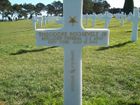
Medal of Honor citation
His Medal of Honor citation reads:
For gallantry and intrepidity at the risk of his life above and beyond the call of duty on 6 June 1944, in France. After 2 verbal requests to accompany the leading assault elements in the Normandy invasion had been denied, Brig. Gen. Roosevelt's written request for this mission was approved and he landed with the first wave of the forces assaulting the enemy-held beaches. He repeatedly led groups from the beach, over the seawall and established them inland. His valor, courage, and presence in the very front of the attack and his complete unconcern at being under heavy fire inspired the troops to heights of enthusiasm and self-sacrifice. Although the enemy had the beach under constant direct fire, Brig. Gen. Roosevelt moved from one locality to another, rallying men around him, directed and personally led them against the enemy. Under his seasoned, precise, calm, and unfaltering leadership, assault troops reduced beach strong points and rapidly moved inland with minimum casualties. He thus contributed substantially to the successful establishment of the beachhead in France.[14]
Theodore Roosevelt, Sr., and Theodore Roosevelt, Jr., are one of only two sets of fathers and sons to have been awarded the Medal of Honor. The other set is Arthur and Douglas MacArthur.
Family
Roosevelt married Eleanor Butler Alexander (1888–1960) on June 20, 1910. They had four children: Grace Green Roosevelt McMillan (1911–1993), Theodore Roosevelt III (1914–2001), Cornelius V.S. Roosevelt (1915–1991) and Quentin Roosevelt II (1919–1948).[15]
See also
- List of Governors of Puerto Rico
- List of Medal of Honor recipients for World War II
- Tunisia Campaign
Notes
- ↑ Department of the Navy – Naval Historical Center: Assistant Secretary of the Navy
- ↑ Stephen Hess, America's Political Dynasties, p. 194 (Garden City, N.Y. : Doubleday & Co., 1966)ISBN 156000911X.
- ↑ "Boyhood Recollections", Average Americans In Olive Drab - The War As Seen By Lt. Col. Theodore Roosevelt, theodoreroosevelt.org, http://www.theodoreroosevelt.org/life/tedsrecollections.htm, retrieved 2008-05-27 in Life of Theodore Roosevelt
- ↑ [1]
- ↑ "Scandal?", TIME, January 28, 1924.
- ↑ Al Smith, George Washington University, http://www.gwu.edu/~erpapers/teachinger/glossary/smith-al.cfm, retrieved 2008-05-27
- ↑ "Teddy" & "Frank", Time magazine, September 12, 1932, http://www.time.com/time/archive/preview/0,10987,744327,00.html, retrieved 2008-05-27
- ↑ "American Legion, "Capsule History of the American Legion," from the "American Legions Post Officers Guide, Appendix 4," pg. 68 Online Edition" (PDF). http://www.legion.org/pdf/pogsection_4_04update.pdf. Retrieved 2007-03-06.
- ↑ "Terrible Terry Allen: The Soldiers' General", by Gerald Astor, Presidio Press; ISBN 0891417605
- ↑ "A Soldier's Story", by: Omar N. Bradley, Publisher: Modern Library, ISBN 0375754210, ISBN 978-0375754210
- ↑ Balkoski, Joseph (2005), "Chapter 7", The Utah Beach: The Amphibious Landing And Airborne Operations On D-Day, June 6, 1944, Stackpole Books, p. 179, ISBN 0-8117-0144-1
- ↑ Balkoski, Joseph (2005), "Chapter 8", The Utah Beach: The Amphibious Landing And Airborne Operations On D-Day, June 6, 1944, Stackpole Books, p. 231, ISBN 0-8117-0144-1
- ↑ Theodore Roosevelt, Jr., and his president father, Theodore Roosevelt, remain one of only two father/son duos to receive the Medal of honor, the other pair being Arthur and Douglas MacArthur. Ted’s father’s medal was awarded posthumously by President Bill Clinton on January 16, 2001.
TR's Family Tree, theodoreroosevelt.org, http://www.theodoreroosevelt.org/life/familytree/Trjr.htm, retrieved 2008-05-27 - ↑ "World War II (M-S); Roosevelt, Theodore, Jr. entry". Medal of Honor recipients. United States Army Center of Military History. http://www.history.army.mil/html/moh/wwII-m-s.html.
- ↑ Almanac of Theodore Roosevelt Genealogy at www.theodore-roosevelt.com
References
 This article incorporates public domain material from websites or documents of the United States Army Center of Military History.
This article incorporates public domain material from websites or documents of the United States Army Center of Military History.
- Almanac of Theodore Roosevelt: Theodore Roosevelt Jr.
- Theodore Roosevelt, 56, Dies On Normandy Battlefield; Succumbs to a Heart Attack Soon After Visit From Son by Hanson W. Baldwin, New York Times, July 14, 1944.
External links
- Theodore Roosevelt Association's bio on Ted, Jr.
- Ted's Boyhood Recollections of his Father
- Medal of Honor recipients on film
|
|||||||||||
|
|||||||||||||||||||||||||||||||||||||||||||
|
|||||||||||||||||||||||
| New York Assembly | ||
|---|---|---|
| Preceded by Franklin Coles |
New York State Assembly, Nassau County 2nd District 1920–1921 |
Succeeded by F. Trubee Davison |
| Government offices | ||
| Preceded by Gordon Woodbury |
Assistant Secretary of the Navy March 10, 1921 – September 30, 1924 |
Succeeded by Theodore Douglas Robinson |
| Party political offices | ||
| Preceded by Nathan L. Miller |
Republican Nominee for Governor of New York 1924 |
Succeeded by Ogden L. Mills |
| Government offices | ||
| Preceded by James R. Beverley |
Governor of Puerto Rico 1929–1932 |
Succeeded by James R. Beverley |
| Preceded by Dwight F. Davis |
Governor-General of the Philippines 1932–1933 |
Succeeded by Frank Murphy |



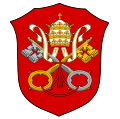
.svg.png)



